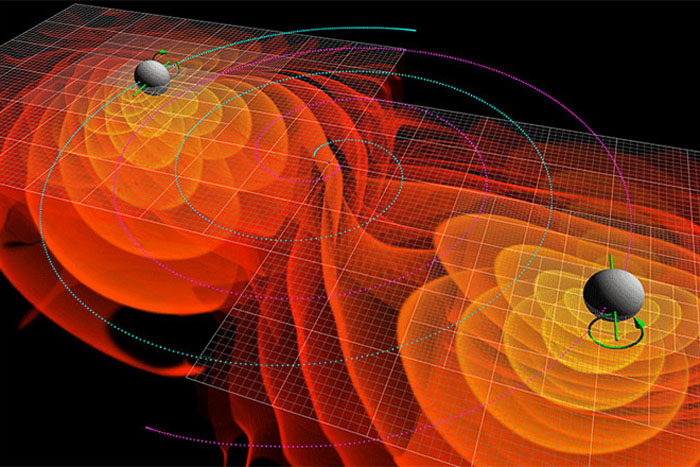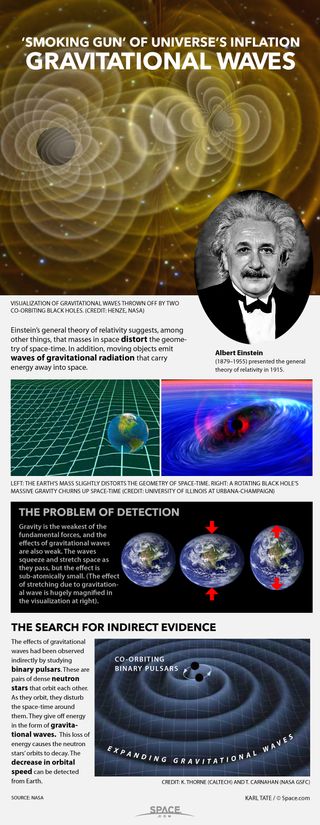Possible Light Flash from Black Hole Collision Spotted

SALT LAKE CITY — When black holes collide, do they hide in the dark or emit flashes of light?
That question is up the air after an Earth-based detector spotted gravitational waves, or ripples in the fabric of space-time, created by two black holes merging together. Previous work suggested that for black holes of this size — about 30 times the mass of the sun — there would be no bright flash, no hazy glow, no light to speak of.
But in September 2015, NASA's Fermi Gamma-ray Space Telescope saw a faint burst of high-energy light less than 1 second after the black holes had collided, and in the same region of the sky. Researchers with the Fermi collaboration discussed the finding yesterday (April 18) at the American Physical Society April Meeting. The chances are good that the gamma-ray light did indeed come from the black-hole merger, but more evidence is needed to nail that conclusion down, scientists said. [Ride the Gravitational Waves of a Black Hole Merger (Video)]
"This is a tantalizing discovery with a low chance of being a false alarm, but before we can start rewriting the textbooks, we'll need to see more bursts associated with gravitational waves from black hole mergers," study lead author Valerie Connaughton, of the National Space, Science and Technology Center in Huntsville, Alabama, said in a statement.
A historic discovery

In February, a collaboration of scientists working at the Laser Interferometer Gravitational-Wave Observatory (LIGO) made history when they announced the first-ever direct detection of gravitational waves, which were first predicted by Albert Einstein a century ago. Up until that detection, scientists had obtained only indirect evidence of these ripples' existence.
The LIGO team determined the waves it had detected came from two black holes, 29 and 36 times the mass of the sun, merging together. Researchers generally didn't expect to see any light coming from this event.
Black holes themselves don't radiate light, but the fast-moving material spiraling into black holes often does. (In fact, monster black holes at the centers of galaxies can cause matter around them to radiate so much light that they become some of the brightest objects in the universe.) However, merging black holes circle each other for millions of years, so scientists had expected that any gas or other nearby light-generating debris would be cleared away long before the duo actually collided.
Get the Space.com Newsletter
Breaking space news, the latest updates on rocket launches, skywatching events and more!
Despite this prediction, researchers combed through the data archives of various telescopes (including Fermi) to hunt for any signs of light emissions from the region to which LIGO traced the two black holes. [Images: Black Holes of the Universe]
"We weren't actually expecting to see anything," said Fermi team member Adam Goldstein, a gamma-ray astrophysicist at NASA's Marshall Space Flight Center in Huntsville, Alabama. Goldstein spoke at a press conference here today at the American Physical Society's April meeting.
But the team did see something: a very faint signal that came from the same region of sky where LIGO made its detection, and that occurred only 0.4 seconds later.
Judy Racusin, an astrophysicist at NASA's Goddard Space Flight Center in Greenbelt, Maryland, said during today's press conference that the Fermi team is "cautiously saying [the gamma-ray signal] is potentially associated with the black hole merger" detected by LIGO.
The researchers are extremely cautious in their assessment, for many reasons. First, the signal wasn't ideal. It came from a region of sky that was underneath the Fermi satellite, so the spacecraft's detectors were essentially seeing the signal in their peripheral vision. The signal is very weak, and Goldstein said it's unclear how much of that is because the detectors weren't looking directly at it, or if it was a weak signal to begin with.
But the LIGO detection makes this otherwise unremarkable gamma-ray burst of great interest to the scientific community, Goldstein and others said.
Based on everything the Fermi team knows about the gamma-ray sky, Goldstein said there is about a "one in 500 chance" that the gamma-ray signal is not associated with the gravitational wave signal, and just happened to appear in the same region of sky at about the same time.
LIGO was able to determine the location of the black hole collision only to within an area spanning 600 square degrees of the sky. (Your clenched fist held at arm's length covers about 10 degrees.) Fermi's detection could reduce that region by two-thirds, but that still leaves a wide range of places where either signal could have come from, reseachers said.
Questions remain
Goldstein and Racusin also discussed a paper released by the INTErnational Gamma-Ray Astrophysics Laboratory (INTEGRAL) collaboration, which showed that the instrument did not detect a signal similar to the one picked up by Fermi. The two scientists said the instrument on INTEGRAL that would have potentially spotted the gamma-ray burst was not built primarily as a gamma-ray burst detector. So it is not possible to directly compare what Fermi sees with what INTEGRAL sees, the scientists said.
Based on what Fermi knows about the signal it detected, Goldstein said, it is "actually not very clear if [INTEGRAL] would have seen it or not."
The new paper about Fermi's gamma-ray detection has been submitted to The Astrophysical Journal and is currently undergoing peer review.
"It is important to note we would not have reported this event just by itself," Goldstein said. "The reason we are publishing is because our data is public, obviously, and the most appropriate people to do this analysis [are in] the instrument team. And so there was particular pressure on us putting out a paper for this."
In the days and weeks following the September LIGO announcement, a handful of papers appeared on the open-access science paper website arXiv.org, throwing out possible physical scenarios in which two midsize colliding black holes could produce a gamma-ray burst. One hypothesis, by astrophysicist Avi Loeb of the Harvard-Smithsonian Center for Astrophysics (CfA) in Massachusetts, suggested that the two black holes had formed in the belly of a single star.
"There [are] a lot of interesting ideas out there, and it was amazing how quickly those ideas were thrown together," Racusin said. "The main idea is that you need to get some sort of matter outside those black holes, some sort of gas to accelerate. … I think it's great how much theoretical speculation this has caused, and we'll see, maybe, in the future [if any of them pan out] with better observations."
"The question that everyone has is, 'Are our observations and LIGO's observations coming from the same object?'" Goldstein said. "And we cannot say definitely right now."
But Goldstein and Racusin said that LIGO is expected to detect more merging black holes in the coming years, as many as 100 such mergers per year at the instrument's peak design sensitivity, Goldstein said.
"So we'll have plenty of opportunities in the next few years to see if other binary black holes have coincident gamma-ray signals," he said.
Follow Calla Cofield @callacofield.Follow us @Spacedotcom, Facebook and Google+. Original article on Space.com.
Join our Space Forums to keep talking space on the latest missions, night sky and more! And if you have a news tip, correction or comment, let us know at: community@space.com.

Calla Cofield joined Space.com's crew in October 2014. She enjoys writing about black holes, exploding stars, ripples in space-time, science in comic books, and all the mysteries of the cosmos. Prior to joining Space.com Calla worked as a freelance writer, with her work appearing in APS News, Symmetry magazine, Scientific American, Nature News, Physics World, and others. From 2010 to 2014 she was a producer for The Physics Central Podcast. Previously, Calla worked at the American Museum of Natural History in New York City (hands down the best office building ever) and SLAC National Accelerator Laboratory in California. Calla studied physics at the University of Massachusetts, Amherst and is originally from Sandy, Utah. In 2018, Calla left Space.com to join NASA's Jet Propulsion Laboratory media team where she oversees astronomy, physics, exoplanets and the Cold Atom Lab mission. She has been underground at three of the largest particle accelerators in the world and would really like to know what the heck dark matter is. Contact Calla via: E-Mail – Twitter